BAFA © 2010. All material here is copyrighted. See conditions above. |
Mustafa Skopljak
painting, sculpture, installations, Bosnia-Herzegovina.
|
Interview with
Sonja van Kerkhoff, 2005
Translation mediated by
Nera Nazecic. Mustafa Skopljak was born in 1947 in Kotor Varoś in north-west Bosnia, and graduated from the Saravego High School for the Arts in 1970. After attending Teachers College, he then studied in the sculpture department of the Saravego Academy of Fine Arts, graduating in 1997 and then again in 1988 with a post graduate degree.
| 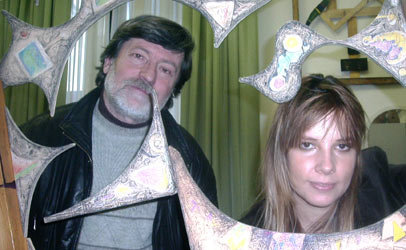
Mustafa Skopljak and Nera Nazecic with a painting by Mustafa in his office at the School of Fine Arts in Saravego, February 2005.
Photo: Sonja van Kerkhoff.
|
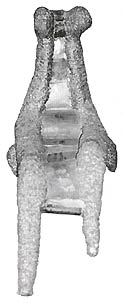
Sculpture by Mustafa Skopljak, 1979. Collection of the
National Gallery in
Banja Luka.
| He has exhibited his work regularly since 1969 in group exhibitions and had solo
shows since 1978.
For example, in 2004 he had work in exhibitions in three Saravego galleries, in Bihać, Bosanka Krupa, Tuzla, Mostar, Miemačka, and Maglaj (Bosnia-Herzegovina). And also in Riga (Latvia), and Sinji Vrh (Slovenia). He has been a member of the Association of Visual Artists of Bosnia-Herzegovina since 1972. In 1982 he did an artist residency in London and has participated in twenty residencies and sculpture symposia between 1977 and 1998. Between 1993 and 1998 he created puppets, sets and costumes for puppet shows for the Saravego Youth Theatre.
He is professor of sculpture at the Saravego Academy of Fine Arts and professor of the Fine Arts Culture department at the Pedagogical College in Mostar.
 
ZZZ, steel sculpture by Mustafa Skopljak, at the 6th Exhibition of Yugoslav Sculpture, Panćevo, 1991.
|
Like other Saravego artists of his generation, the 1992-96 siege could not but have a powerful impact on Mustafa Spopljak's work. It informed his language but didn't create it.
|
 It is probable that without the siege his work might not have appeared on the cover of the May 1994 Art in America, but his Witnesses of Evidence installation would not have been so powerful if hadn't come out of his life and work developed over two decades, and it was certainly influenced by his artist climate (communist Yugoslavia), that in some cases was a struggle and in other ways was more supportive than some western countries are of their artists. What impressed me in meeting a number of the Saravego artists in 2005 was the edge and conviction in their work. Perhaps they had to develop this edge in order to continue and survive, but a decade later, what I see in their work is more than a reconstruction It is probable that without the siege his work might not have appeared on the cover of the May 1994 Art in America, but his Witnesses of Evidence installation would not have been so powerful if hadn't come out of his life and work developed over two decades, and it was certainly influenced by his artist climate (communist Yugoslavia), that in some cases was a struggle and in other ways was more supportive than some western countries are of their artists. What impressed me in meeting a number of the Saravego artists in 2005 was the edge and conviction in their work. Perhaps they had to develop this edge in order to continue and survive, but a decade later, what I see in their work is more than a reconstruction
- a retelling: it is a reworking, a process.

Detail of an installation in the National Gallery, Saravego, 2004.
|

Detail of a 'relief' painting in the National Gallery, Saravego, 2004.
|
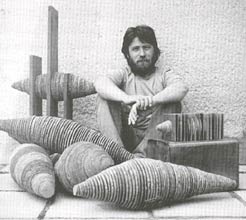 
Mustafa Skopljak with his work circa 1985. One of these pieces is in the Collection of the Saravego National Gallery, the others were destroyed
when his studio was bombed in 1993.
|
Mustafa Skopljak's current works hang in the 'spaces' between things. From a distance the paintings above seem to consist of abstract elements, but a closer look shows that almost each painting contains a contoured human face. The painting above contains more than ten face images imbedded under the surface of the work.
The installation above is both a series of paintings -and sometimes he presents his work as objects in a more traditional gallery setting- and a total experience evocative of the transitory.
The works themselves are figurative and abstract which invoke the narrative and the mediative.
From the 1970's onwards, a characteristic element in his oeuvre were his 'spindle' forms. They were and are a reduction of the human prone form. Usually they are carved in wood and painted in bright colours reminiscent of Balban folk costume and decoration.
|
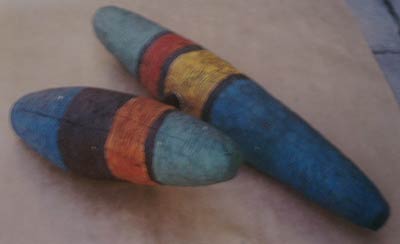
Sculpture by Mustafa Skopljak, in the 1989 Documenta Yugoslavia. Initiated in 1984, this was the third Documenta held in Saravego,
show-casing work from all over Yugoslavia.
| These 'spindle' forms were recognized by Yugoslav art critics as unique and yet distinctively Balkan, so his work was often selected for exhibitions within Yugoslavia and abroad. 
Untitled, stone, by Mustafa Skopljak made in the fine arts colony and residency Forma Viva '89, Portorož, Bosnia.
|
 Mustafa Skopljak's 'spindle' works also seem 'primitive' (This part of Bosnia has traces of habitation from the past 5000 years) and his vertically placed works have a tomb-like mediative quality to them. Mustafa said that these works are influenced by his archeological landscape. Mustafa Skopljak's 'spindle' works also seem 'primitive' (This part of Bosnia has traces of habitation from the past 5000 years) and his vertically placed works have a tomb-like mediative quality to them. Mustafa said that these works are influenced by his archeological landscape.

| 
Untitled, steel, by Mustafa Skopljak made in the fine arts colony and residency Steel Zenica, 1991, Zenica, Bosnia.
< Terra '87, ceramic, about 2 metres long, by Mustafa Skopljak, commissioned by the 1987 Terra symposium in Kikinda, now Serbia. Later that year he exhibited 50 ceramic sculptures made at this symposium in a solo show in Belgrade which was then short-listed for a city "best exhibition" (the Politika Prize) prize.
Before the 1992 war he worked in many materials, from ceramics to steel to cardboard.
During the seige, he worked with what was around him. Broken glass and rubble.
|
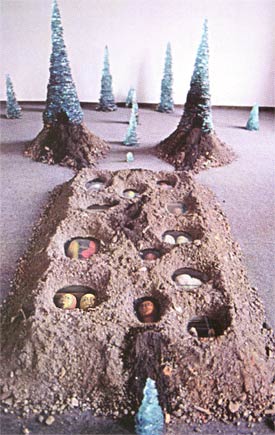 Installation, Witnesses of Existence by Mustafa Skopljak. As installed in the National Gallery, Saravego in 1993. Below: Detail of this.

| The war that ravaged Saravego for over 1400 days from 1992 to 1995 was the longest siege in modern history. Sarajevans lived without water, electricity or food for almost four years. Over 11000 were killed including 1500 children.
Mustafa's home and studio were in the Grabica area, which was occupied by the Serb army from early on. His street was referred to as sniper alley. Mustafa's wife and daughter went to family in Slovenia but he chose to stay as a matter of principle. He continued to teach sculpture in the art academy, sleeping for 4 years in his office at the art school. It was bombed five times while he was there.
Times were very hard but he also kept making his art - out of necessity and out of solidarity. The intent of the siege was intended to exterminate the life and culture of Saravego.
So he did his best as a teacher and as an artist to keep going. He was also inspired by the determination of others around him, including his students. One of these was Nebojša Šerić-Shoba (now based in New York) who was one of the 4 artists represented at the 2003 Venice Biennale.
Witnesses of Existence
In the winter of '92/93, in a city without electricity, filmmaker, Mirsad Purivatra (now director of the annual Saravego Film Festival) helped to organize and filmed an exhibition/installation /process in the half-ruined Sutjeska cinema, which the public used as a passageway safe from snipers. Each of the artists: Zoran Bogdanović, Sanjin Jukić, Ante Jurić, Edin Numankadić, Nusret Pašić, Mustafa Skopljak, Radoslav Tadić, and Petar Waldegg took turns to work in the space for 7 days, sometimes with light from a generator, sometimes not. The resulting video was shown at the 1993 Venice Biennale and the impact of it blew me away. Neither the artists nor their work were allowed out of Saravego for the Biennale, but they got video and other documentation out. Friends from Slovenia organized a catalogue, a press release and the exhibition.
In the video you see Mustafa take rubble and spread it out on the ground. He then made depressions into this with his hands and inserted painting of face into each. Over the 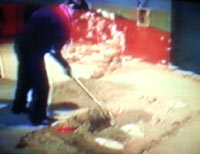 face he placed a piece of broken glass which was partly buried in the rubble. He then covered each face and planted a tower of broken glass over each. face he placed a piece of broken glass which was partly buried in the rubble. He then covered each face and planted a tower of broken glass over each.
|

Seven days after the exhibition opened in April 1993, Mustafa's home and studio were bombed and he lost most of his sculptures and paintings from the last twenty years. Like many in Saravego, he now lives back in the some top appartment which has been reconstructed as it was. Of course his work cannot be reconstructed.
Their work at the 1993 Venice Biennale was impressive and the exhibition then toured further. Mustafa said that they heard that there was positive news about their work about a week after the Biennale opened and that it gave them support. In February 1994 some of these artists were able to travel to New York to accompany their work in the New York City Kunsthalle.
In December 1994 Arts Dialogue published a review of this exhibition written by Johannes Birringer.
Back in Saravego and still under seige, Mustafa's work intensified more in the form of installation because he could use this medium to 'speak' more sharply.
| 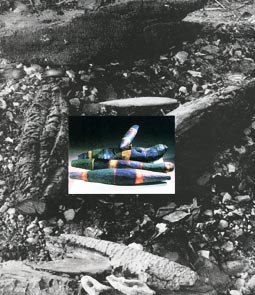
Remains of Mustafa Skopljak's sculpture from the series Remains of the Nude (inset shows how it was in 1983 Yugoslav Contemporary Art 1978 - 1983 exhibition, held at the Collegium Artisticum in Saravego).
|
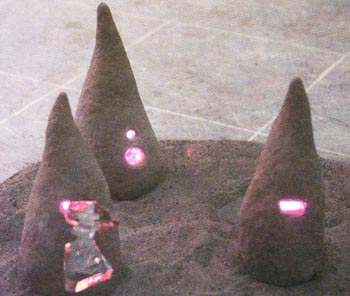 Detail of the installation, With Light and Dark by Mustafa Skopljak, in the Obala Art Centre Gallery, 1998. 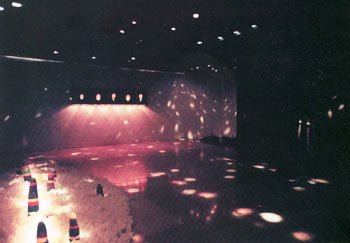 Overview of the installation: With Light and Dark, 1998.
Below: Detail of the same installation. 
|
"The first war installations were combinations of constructed and found elements. Spiral-conical shapes of glass shattered by detonations and direct hits, illuminated by the flame of wax candles, were driven into the ashes, sand and coal gathered from Saravego's burnt remains. These kinds of installations became condensed metaphors of a powerful conviction about some [kind of] ritual and sacred place.... These installations are products of Skopljak's concealed anxiety and hope... In their meaningful layers are hidden a multitude of symbols, enigmas, mythic and archetypical images, the dualism of construction and destruction."
Excerpt from an essay by Meliha Hudesdžinović, director of the Saravego National Gallery, in a catalogue of Mustafa Skopjlak's work accompanying an exhibition in the Saravego Centre for Contemporary Arts, 2000.
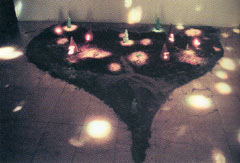 Detail of the installation, With Light and Dark by Mustafa Skopljak, in the Obala Art Centre Gallery, 1998.
 He started using the 'face' motif, during the war partly as a sort of 'scream' (The reference to Munch is conscious) and partly because the face is about the most tangible icon for the human / humane you can use. He started using the 'face' motif, during the war partly as a sort of 'scream' (The reference to Munch is conscious) and partly because the face is about the most tangible icon for the human / humane you can use.
Mustafa's use of the face motif is also inspired by a quotation by the Bosnian writer Ivo Andić (who won 1961 Nobel Prize for Literature), "There is not enough time to absorb all the faces in the stars".
|
 The face motif, always drawn with fluid contour lines, sometimes coloured, sometimes embedded under a surface, and often incorporated with the use of black (a reminder and remainder of his impressions of his burnt out studio) is recurring element in both his painting-sculptures (or object-paintings) and installations. The face motif, always drawn with fluid contour lines, sometimes coloured, sometimes embedded under a surface, and often incorporated with the use of black (a reminder and remainder of his impressions of his burnt out studio) is recurring element in both his painting-sculptures (or object-paintings) and installations.

Two hanging painting-objects (with their shadows)
in his home, 2005.
> Detail of an object-painting (c. 1 metre high) by Mustafa Skopljak, 2000. The three faces are paintings recessed behind a plate of glass which has been inserted into the surface of the painting. He has used a mixture of bitumin, sawdust and glue for the relief areas in the work.
|  Spirit of Light, performance by Mustafa Skopljak at the Second Annual Exhibition of the Soros Centre of Contemporary Arts, Saravego, 1998.  |

Painting on glass by Mustafa Skopljak, 2005.
Mustafa Skopljak travels once a week to Mostar
(a 2 hour train journey each way) to teach art at the Pedagogical institute, not because he needs to financially, but because it is a way of giving something back -as a mission. Mostar is also a different city to Saravego and this stimulates him as does meditating on the passing landscape during his journey.
| 
He finds that teaching at the two institutes, complements his own work, he learns from the students as they learn from him. For him teaching is part of his artistic process. He is head of the sculpture department which offers a 4 year degree plus 2 year Masters Degree. He has 24 students in his department, where 4 are doing the Master's level. Currently the academy has departments in painting, printmaking, graphic design, and product design, plus a 2 year course in restoration work.

Mustafa Skopljak, 2005, with his work in his office (which he lived in between 1992 and 1995) at the Academy of Fine Arts in Saravego.
|

Arts Dialogue, Dintel 20, NL 7333 MC, Apeldoorn, The Netherlands
email: bafa@bahai-library.com
|
|
















 face he placed a piece of broken glass which was partly buried in the rubble. He then covered each face and planted a tower of broken glass over each.
face he placed a piece of broken glass which was partly buried in the rubble. He then covered each face and planted a tower of broken glass over each.




